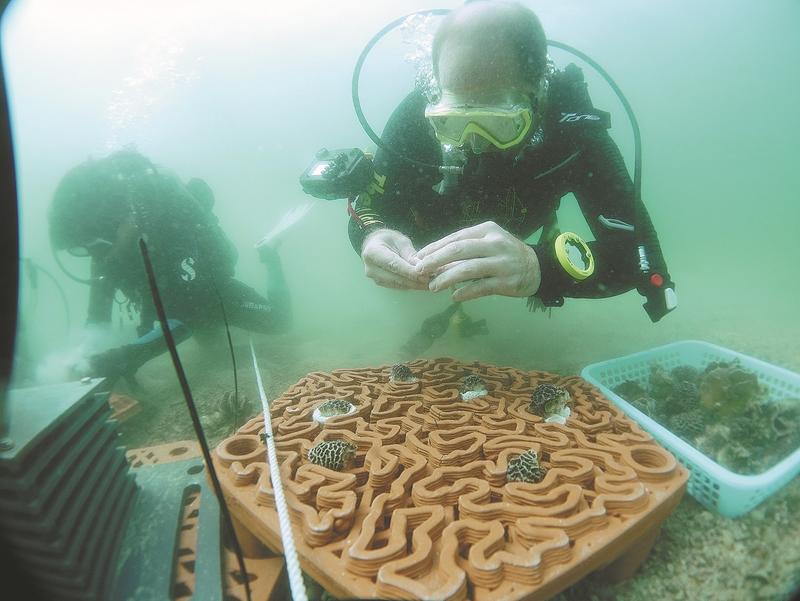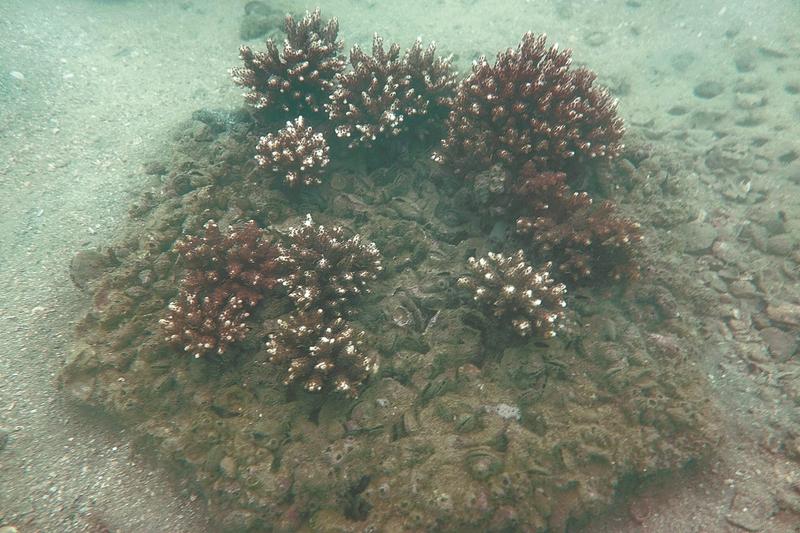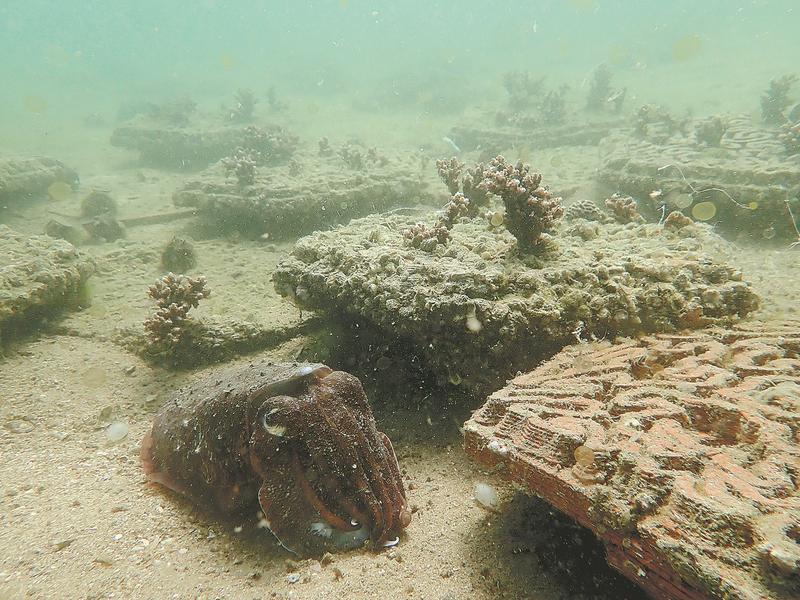 Zhuhai Yunzhou Intelligence Technology, headquartered in Zhuhai, Guangdong province, focuses on manufacturing multifunctional unmanned boats and above-water robots. (PHOTO PROVIDED TO CHINA DAILY)
Zhuhai Yunzhou Intelligence Technology, headquartered in Zhuhai, Guangdong province, focuses on manufacturing multifunctional unmanned boats and above-water robots. (PHOTO PROVIDED TO CHINA DAILY)
Joint contributions aid rescue work, help restore ocean life
An orange-colored flash in the shape of a surfboard cut through a raging sea off Weihai, Shandong province, on Aug 9, before quickly returning with a 15-year-old boy, who was scared and drenched, but otherwise unharmed.
This robotic device was controlled by a police officer on the shoreline. The teenager, who was washed out to sea about 100 meters off the coast, was almost lost to the depths. Had it not been for the device, it would have been extremely difficult to save him, as rescuers faced gale-force winds and tumultuous waves.
Police recorded video footage of the robotic rescue mission, and the special operation went viral on the internet. Countless netizens said they were amazed by the robot.
The device, Hai Tun 1, or Dolphin 1, which is 1.19 meters long and 0.85 meters wide, is powered by two pump jets on each side of its tail. It was developed by Zhuhai Yunzhou Intelligence Technology, which is based in Zhuhai, Guangdong province.
The successful rescue operation also offered a glimpse of the robust marine technology industry in the Guangdong-Hong Kong-Macao Greater Bay Area, or GBA.
READ MORE: Xi calls for building GBA's strength in sci-tech innovation
Zhuhai Yunzhou Intelligence Technology has been focusing on manufacturing multifunctional unmanned boats and above-water robots for more than a decade. The company sells over 30 types of unmanned boats and rescue robots for use in environmental monitoring, marine surveys, and patrols and lifesaving missions on water.
The electrically powered device can travel over water at three meters per second, carry a maximum weight of 150 kilograms, and operate for 30 minutes on a full charge, according to the company.
The robot's controller resembles a pistol, with a screen displaying the device's speed, battery level and other data. Holding the controller, rescue workers command the robot via microwaves, and it can be used for rescue work up to 800 meters offshore.
 "Dolphin 1", the rescue robot, travels over water at three meters per second. (PHOTO PROVIDED TO CHINA DAILY)
"Dolphin 1", the rescue robot, travels over water at three meters per second. (PHOTO PROVIDED TO CHINA DAILY)
Those rescued at sea by the device can either climb onto the robot or grab handles installed on its body to be taken back to shore.
Zhuhai Yunzhou Intelligence Technology boasts a team of more than 300 developers and has over 400 registered patents for unmanned boats and robots, according to Lin Bingsen, the company's manager for South and Southwest China
The device weighs 13.75 kg, and it can be carried on a rescue worker's back. Rescuers can also install cameras and microphones to communicate with victims in real time, and small searchlights can be attached to the robot for work during darkness.
In addition to rescue robots, the Zhuhai company's unmanned boats have been used for scientific research and maritime security work in recent years.
In November 2017, China's polar research vessel the Xue Long, or Snow Dragon, was equipped with a survey boat manufactured by the company, which carried out seabed surveys in waters off Antarctica. Patrol boats developed by the company also took part in an anti-smuggling exercise in Lianyungang, Jiangsu province, in September the following year.
ALSO READ: Further integration urged to tap GBA’s inno-tech potential
Zhuhai Yunzhou Intelligence Technology boasts a team of more than 300 developers and has over 400 registered patents for unmanned boats and robots, according to Lin Bingsen, the company's manager for South and Southwest China.
In addition to customers from the Chinese mainland, Lin said the Water Supplies Department in the Hong Kong Special Administrative Region, the Macao SAR Marine and Water Bureau, and universities in the two cities have bought the company's unmanned boats for water quality testing and scientific research. The company has also sold nearly 1,000 rescue robots such as the Dolphin 1 to more than 40 overseas countries and regions, Lin added.
The collective effect of high-quality scientific research talent and resources of the GBA is key to such innovative efforts.
The development team at Zhuhai Yunzhou Intelligence Technology includes talent from the mainland and Hong Kong, and many of the company's employees have either worked or studied in Hong Kong.
ALSO READ: Inno-tech integration ‘catalyst’ for growth
The company was founded by two graduates from Hong Kong University of Science and Technology, or HKUST, in 2010. Their Hong Kong connections helped them tap the resources of the city's science sector.
Joint laboratories have been set by the company with Hong Kong's universities, especially HKUST, to advance research on robotic materials, communication technologies and energy over the past few years.
 Divers transplant corals onto the 3D-printed reef tiles produced by Archireef, a Hong Kong startup. (PHOTO PROVIDED TO CHINA DAILY)
Divers transplant corals onto the 3D-printed reef tiles produced by Archireef, a Hong Kong startup. (PHOTO PROVIDED TO CHINA DAILY)
Tech 'windows'
With mainland companies tapping Hong Kong's scientific research resources to develop their marine technology products, the city's marine scientists view cities in the Greater Bay Area as "windows "for technology commercialization.
The team from HKUST uses biological methods and compounds extracted from deep-sea microbes to prevent organisms from attaching themselves to ships' hulls or other objects in the water. The scientific discoveries behind this technology won the university a second prize at the 2016 National Natural Science Awards
In 2016, a research team from HKUST developed a butenolide antifouling coating for vessels and fishing nets that resulted in reduced toxicity to the marine environment. The university listed the product as a key technology transfer project.
Three years later, two companies in Hong Kong and Shenzhen, both funded by HKUST, won the exclusive right to this technology. They were chosen because they were considered the best candidates to use the GBA's industrial chain to propel the antifouling coating's commercialization.
Traditionally, this coating is applied to vessels to prevent marine organisms and microbes from clinging to their hulls at sea.
Ma Ye, CEO of Ocean Science (Hong Kong), one of the companies that obtained HKUST's license, said toxic materials are traditionally added to the antifouling coating to kill organisms and microbes attached to the hull. She added that these toxins are released into the ocean, polluting the water and marine life.
READ MORE: Talents hold key to inno-tech growth
However, without an antifouling coating, marine organisms easily attach themselves to the hull of a vessel, slowing its speed by up to 30 percent and increasing its fuel consumption by a maximum of 40 percent, which in turn impact the cost of marine transportation, Ma said.
The team from HKUST uses biological methods and compounds extracted from deep-sea microbes to prevent organisms from attaching themselves to ships' hulls or other objects in the water. The scientific discoveries behind this technology won the university a second prize at the 2016 National Natural Science Awards.
Ma and her colleagues also refined the technology and applied it to fishing nets. She said traditional antifouling coatings are usually developed for hard materials such as steel, aluminum alloy and glass fiber that are commonly used to build ship's hulls, but marine life also attaches itself to items such as fishing nets.
When organisms grow on top of a fishing net, they reduce the exchange of water and oxygen and harm the catch, Ma said. But as antifouling coatings are generally toxic, they are inappropriate for use on such nets, as the coating will harm fish and other creatures in the net, she added.
For fish to survive longer in the nets, they are often fed antibiotics, which may harm the health and quality of the fish, as well as those consuming them, Ma said.
READ MORE: Advisers propose more support for GBA inno-tech sector
Developing coatings for items such as fishing nets is a new challenge for Ma and her team. The aim is to strengthen the coating's flexibility and adhesion so that it does not easily flake off the net, Ma said. Ocean Science has research and development bases in Zhuhai and Shenzhen, Guangdong. Ma said the GBA's mature industrial chain makes it easier to produce coatings and conduct experiments.
"The environmentally friendly antifouling coating has broad market prospects, as more people in China realize the importance of protecting the marine environment," Ma added.
Currently, 1 kg of the antifouling coating produced by Ma's company costs thousands of yuan, far more expensive than a traditional coating that costs several hundred yuan per kg.
The initial cost of the coating was more than 10,000 yuan ($1,436) per kilogram, significantly inhibiting its application in the market. Ma's next step is to further reduce the cost by improving the manufacturing process.
 Corals growing on a 3D-printed reef tile. (PHOTO PROVIDED TO CHINA DAILY)
Corals growing on a 3D-printed reef tile. (PHOTO PROVIDED TO CHINA DAILY)
More efforts
Some companies are stepping up efforts to return life to marine waters.
For example, Archireef, a Hong Kong startup produces 3D-printed reefs to help coral that has lost its habitat to human activities.
Vriko Yu, the company's co-founder and CEO, said artificial coral reefs on the market are mainly made from concrete, which compared with seawater, has a much higher pH value — a measurement of the acidity or alkalinity of a solution based on the amount of hydrogen in the water. As a result, concrete is unsuitable for the growth of marine life.
Yu's company makes reef tiles from clay soil, the pH value of which is closer to that of the marine environment. The developers add features to these artificial tiles via 3D printing technology. For instance, tiles printed by using such technology have intricate ridges that resemble the structure of real reefs.
In addition, three supports raise the reef tiles above ground, protecting coral from being eroded by sediment on the seabed.
ALSO READ: Emergence of an inno-tech hub
The 3D-printed reef tiles have been installed at locations in Hong Kong such as Hoi Ha Wan Marine Park and Deep Water Bay to help restore the ecosystem and coral.
In September, Archireef established a branch in Abu Dhabi, United Arab Emirates, and applied such tiles to local marine conservation.
Last year, the output value of Guangdong's marine-related industries reached 1.99 trillion yuan, ranking first on the Chinese mainland for 27 consecutive years, according to the Guangdong Marine Economy Development Report (2022).
 Corals growing on a 3D-printed reef tile. (PHOTO PROVIDED TO CHINA DAILY)
Corals growing on a 3D-printed reef tile. (PHOTO PROVIDED TO CHINA DAILY)
Shenzhen, the GBA's powerhouse, has been home to China's largest marine exhibition, the China Marine Economy Expo, since 2019. This year, more than 1,000 exhibitors and 300 industrial leaders from home and abroad took part in the expo, discussing and exchanging their views on the GBA and the nation's marine economy.
Experts said at the expo that as long as scientific research and collaborative regional innovation continues to be strengthened in the GBA, marine technology companies will find a broader stage for development and make a greater contribution to the Chinese marine economy.
Meanwhile, Zhuhai Yunzhou Intelligence Technology is developing a new system that allows rescue workers to complete their tasks without getting their feet wet.
The system comprises a network of security cameras, lifesaving equipment storage boxes, and rescue robots such as the Dolphin 1.The surveillance cameras identify people in danger in the water and send warnings back to a central control room. Staff members in the control room then open an equipment storage box placed nearby through remote control, activate a robot in the box and send it to locate and help those in trouble in the sea.
The system was first used in Zhuhai a few months ago. Despite the short time it has been in use, it has received a good response from many mainland companies and local governments, according to Lin, the company's manager for South and Southwest China. He added that the system will next be installed at Yantian Port, Shenzhen.
People making a living from the sea are wise to be wary of nature, but marine technology such as the Dolphin 1 takes inspiration from marine life to save humans. It also helps us better understand nature to protect marine fauna and flora.


